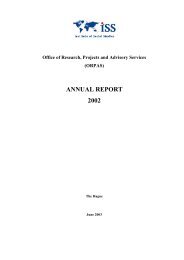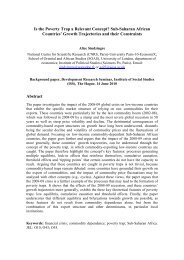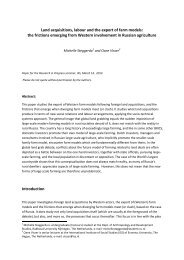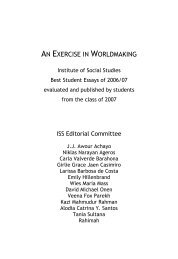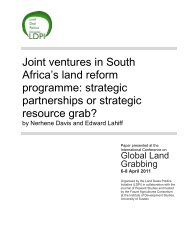AN EXERCISE IN WORLDMAKING 2009 - ISS
AN EXERCISE IN WORLDMAKING 2009 - ISS
AN EXERCISE IN WORLDMAKING 2009 - ISS
You also want an ePaper? Increase the reach of your titles
YUMPU automatically turns print PDFs into web optimized ePapers that Google loves.
14 Unpacking the Politics of Veil in the Context of Bangladesh 165<br />
Contrary to that, “fundamentalist Islamic” groups are highly vocal on<br />
insisting women to wear burqa. The issue of the burqa becomes more<br />
critical when these groups consider the whole Middle Eastern veil debate<br />
as a Western attack on the Muslim world, and use the burqa as a tool to<br />
express their strong rejection towards the Western model of modernity<br />
(Feldman and McCarthy, 1983; Kabeer, 1991; Rozario, 2006: 375). They<br />
coincide with women’s increasing visibility as a replication of Western<br />
modernity, which is anti-Islamic according to them. Therefore, as a solution<br />
in returning to the Islamic path, they choose to be followers of the<br />
Middle East and impose burqa on women as a “proper Islamic dress”<br />
(Feldman and McCarthy, 1983; Kabeer, 1991; Rozario, 2006: 375). Yet,<br />
Middle Eastern “Muslim women” are not a homogenous group; neither<br />
is there a fixed concept of the veil that may only refer to burqa (Keyman,<br />
2007; Kirmani, <strong>2009</strong>: 48-49; Abu-Lughod, 2006, 2002, 1998; Scott,<br />
2007). Accordingly, similar to the feminist groups, they also fall under<br />
the trap of the Westernized discourse of “Muslim women” as a fixed<br />
category and use this category as a defensive mechanism for their “antimodernity”<br />
project against Bangladeshi women. With several threatening<br />
occurrences, many of these groups have warned all Muslim and non-<br />
Muslim women to wear burqa otherwise they will be killed (Chowdhury,<br />
2005; Freedman, 1996:58; Kabeer, 1991; Rozario, 2006).<br />
Given this larger spectrum of politics behind the veil in Bangladesh,<br />
whenever any woman wears burqa gets many dubious identities imposed<br />
on her; on one hand, she is recognized as a good Muslim woman, pious<br />
and submissive, but on the other hand she is oppressed, conservative,<br />
lacks agency, powerless, property of a “patriarchal” male and needs to be<br />
emancipated. Questions arise as to why do we essentialize these identities<br />
with the veil? Why do we place burqa users within different dichotomous<br />
identities? Attempts to answer these questions unmask the broader politics<br />
of orientalism through which specific discourses of “Muslim Culture”<br />
and “veiled women” are created by the West, politically represented<br />
through the Western media and reinforced by the rest of the<br />
world where consciously and unconsciously people are using these orientalised<br />
imagery of the veiled women.<br />
ORIENTALISATION OF VEIL- THE D<strong>AN</strong>GER WITH FIXITY OF “CULTURE”<br />
The complexities surrounding burqa in Bangladesh are influenced by the<br />
larger discourse of “Muslim veiled women”, which can be best explained




